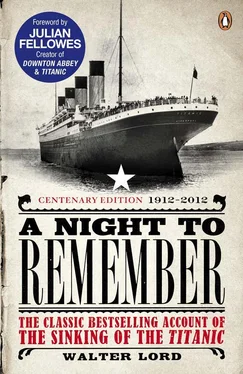The scene in third class was particularly confusing because the White Star Line primly quartered the single men and single women at opposite ends of the Titanic . Now many of the men—who slept towards the bow—hurried aft to join the girls.
Katherine Gilnagh, a pert colleen not quite sixteen, heard a knock on the door. It was the young man who had caught her eye earlier that day playing the bagpipes on deck. He told her to get up—something was wrong with the ship. Anna Sjoblom, an eighteen-year-old Finnish girl bound for the Pacific Northwest, woke up when a young Danish swain came in to rouse her room-mate. He also gave Anna a lifebelt and urged her to come along. But she was too seasick to care. Eventually there was so much commotion that she went up after all, even though she still felt awful. She was quickly helped into a lifebelt by Alfred Wicklund, a schoolfriend from home.
Among these young men, Olaus Abelseth was especially worried. He was a twenty-six-year-old Norwegian heading for a South Dakota homestead, and an old family friend had put a sixteen-year-old daughter in his care until they reached Minneapolis. As he pushed his way aft along the E deck working alleyway, Minneapolis seemed a long way off.
Abelseth found the girl in the main steerage hallway on E deck. Then, along with his brother-in-law, a cousin and another girl, he climbed the broad, steep third-class stairs to the poop deck at the very stern of the ship.
Into the bitter night the whole crowd milled, each class automatically keeping to its own decks—first class in the centre of the ship, second a little aft, third at the very stern or in the well deck near the bow. Quietly they stood around waiting for the next orders… reasonably confident yet vaguely worried. With uneasy amusement they eyed how one another looked in lifebelts. There were a few half-hearted jokes.
‘Well,’ said Clinch Smith as a girl walked by carrying a Pomeranian, ‘I suppose we ought to put a life preserver on the little doggie too.’
‘Try this on,’ a man told Mrs Vera Dick as he fastened on her life jacket. ‘They are the very latest thing this season. Everybody is wearing them now.’
‘They will keep you warm if you don’t have to use them,’ Captain Smith cheerfully explained to Mrs Alexander T. Compton of New Orleans.
At about 12.30 Colonel Gracie bumped into Fred Wright, the Titanic ’s squash pro. Remembering he had reserved the court for 7.30 in the morning, Gracie tried a little joke of his own: ‘Hadn’t we better cancel that appointment?’
‘Yes,’ replied Wright. His voice was flat and without enthusiasm, but the wonder is he played along at all. He knew the water was now up to the squash-court ceiling.
In the brightly lit gym, just off the boat deck, Mr and Mrs Astor sat side by side on a pair of motionless mechanical horses. They wore their lifebelts, and Mr Astor had an extra one in his lap. He was slicing it open with his penknife, whiling away the time by showing his wife what was inside.
While the passengers joked and talked and waited, the crew moved swiftly to their stations. The boat teemed with seamen, stewards, firemen, chefs, ordered up from below.
A curiously late arrival was Fifth Officer Harold Godfrey Lowe. A tempestuous young Welshman, Lowe was hard to suppress. When he was fourteen, his father tried to apprentice him to a Liverpool businessman, but Lowe said he ‘wouldn’t work for nobody for nothing’. So he ran away to sea and a life after his own heart—schooners… square-riggers… five years steaming along the West African coast.
Now, at twenty-eight, he was making his first trip across the Atlantic. This Sunday night he was off duty and slept through the collision. Voices outside his cabin on the boat deck finally woke him up. When he looked out of the porthole and saw everybody in lifebelts, he catapulted out of bed, into his clothes, and rushed on deck to help. Not exactly an auspicious start, but then, as Lowe later explained to US senator Smith, ‘You must remember that we do not have any too much sleep, and therefore when we sleep we die.’
Second Officer Charles Herbert Lightoller was late too, but for an entirely different reason. Like Lowe, he was off duty in his bunk when the Titanic hit, but he woke up instantly and, in his bare feet, ran out on the boat deck to see what was up. Nothing could be seen on either side of the ship, except on the starboard wing of the bridge, where he dimly made out Captain Smith and First Officer Murdoch. They too were peering out into the night.
Lightoller returned to his cabin and thought it over. Something undoubtedly was wrong with the ship—first that jar, now the silent engines. But he was off duty and, until called, it was no business of his. When they needed him, they would send for him. When this happened, he should be where they’d expect to find him. Lightoller got back into bed and lay awake waiting …
Five, fifteen, thirty minutes went by. He could now hear the roar of the funnels blowing off steam, the rising sound of voices, the clanking of gears. But still, his duty was to be where they’d expect to find him.
At 12.10 Fourth Officer Boxhall finally came bursting in: ‘You know we have struck an iceberg.’
‘I know we have struck something,’ Lightoller replied, getting up and starting to dress.
‘The water is up to F deck in the mail room,’ continued Boxhall, by way of a little prodding. But no urging was needed. Lightoller was already well on the way. Cool, diligent, cautious, he knew his duty to the letter. He was the perfect Second Officer.
On the boat deck men began to clear the sixteen wooden lifeboats. There were eight on each side—a cluster of four towards the bow, then an open space of 190 feet, then another four towards the stern. Port boats had even numbers, starboard odd. They were numbered in sequence, starting from the bow. In addition, four canvas collapsible lifeboats—known as Englehardts—were stowed on deck. These could be fitted into the empty davits after the two forward boats were lowered. The collapsibles were lettered A, B, C and D.
All the boats together could carry 1,178 people. On this Sunday night there were 2,207 people on board the Titanic .
This mathematical discrepancy was known by none of the passengers and few of the crew, but most of them wouldn’t have cared anyhow. The Titanic was unsinkable. Everybody said so. When Mrs Albert Caldwell was watching the deck hands carry up luggage at Southampton, she had asked one of them, ‘Is this ship really non-sinkable?’
‘Yes, lady,’ he answered. ‘God Himself could not sink this ship.’
So now the passengers stood calmly on the boat deck—unworried but very confused. There had been no boat drill. The passengers had no boat assignments. The crew had assignments, but hardly anybody bothered to look at the list. Now they were playing it strictly by ear—yet somehow the crew seemed to sense where they were needed and how to be useful. The years of discipline were paying off.
Little knots of men swarmed over each boat, taking off the canvas covers, clearing the masts and useless paraphernalia, putting in lanterns and tins of biscuits. Other men stood at the davits, fitting in cranks and uncoiling the lines. One by one the cranks were turned. The davits creaked, the pulleys squealed and the boats slowly swung out free of the ship. Next, a few feet of line were paid out, so that each boat would lie flush with the boat deck… or, in some cases, flush with promenade deck A directly below.
But the going was slow. Second Officer Lightoller, in charge of the port side, believed in channels, and Chief Officer Wilde’s side seemed quite a bottleneck. When Lightoller asked permission to swing out, Wilde said, ‘No, wait.’ Lightoller finally went to the bridge and got orders direct from Captain Smith. Now Lightoller asked Wilde if he could load up. Again Wilde said no; again Lightoller went to the bridge; again Captain Smith gave him the nod: ‘Yes, put the women and children in and lower away.’
Читать дальше












